
DTF Film: The Vibrant Canvas Revolutionizing Custom Printing and Textile Innovation
2025-09-12 16:59 In the whirlwind world of custom creation, where a single design can transform a plain T-shirt into a statement piece or a wooden sign into a rustic heirloom, DTF film emerges as the unsung architect of endless possibilities. Standing for Direct-to-Film, this specialized transfer medium—typically a thin sheet of polyethylene terephthalate (PET)—serves as the bridge between digital dreams and tangible reality. Crafted through precise extrusion and coating processes, 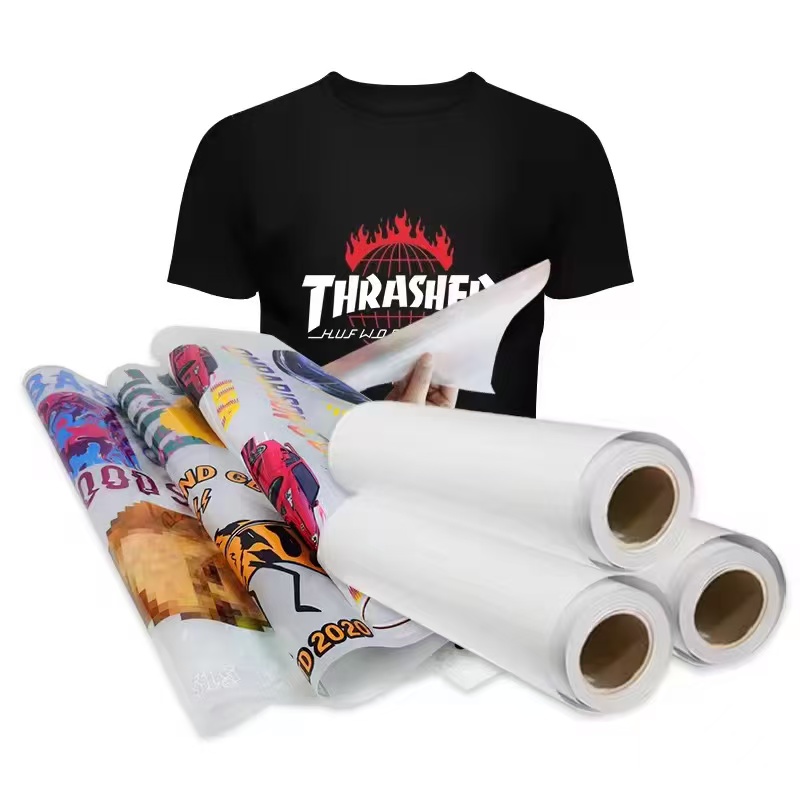 DTF film boasts thicknesses ranging from 0.075mm to 0.15mm, offering a lightweight yet robust canvas that weighs in at a mere 75-100 g/m². Its translucent surface, with clarity levels exceeding 90%, captures inkjet-printed designs with photographic fidelity, while an adhesive layer—activated by heat—ensures seamless bonding to diverse substrates. Picture a bustling print shop at dawn: rolls of DTF film unspool under humming printers, white underbases blooming like fresh snow before vibrant CMYK layers dance atop them, ready to leap onto fabric or foam with a sizzle from the heat press. This isn't just film; it's a catalyst for creativity, blending high-tech precision with artisanal flair.
DTF film boasts thicknesses ranging from 0.075mm to 0.15mm, offering a lightweight yet robust canvas that weighs in at a mere 75-100 g/m². Its translucent surface, with clarity levels exceeding 90%, captures inkjet-printed designs with photographic fidelity, while an adhesive layer—activated by heat—ensures seamless bonding to diverse substrates. Picture a bustling print shop at dawn: rolls of DTF film unspool under humming printers, white underbases blooming like fresh snow before vibrant CMYK layers dance atop them, ready to leap onto fabric or foam with a sizzle from the heat press. This isn't just film; it's a catalyst for creativity, blending high-tech precision with artisanal flair.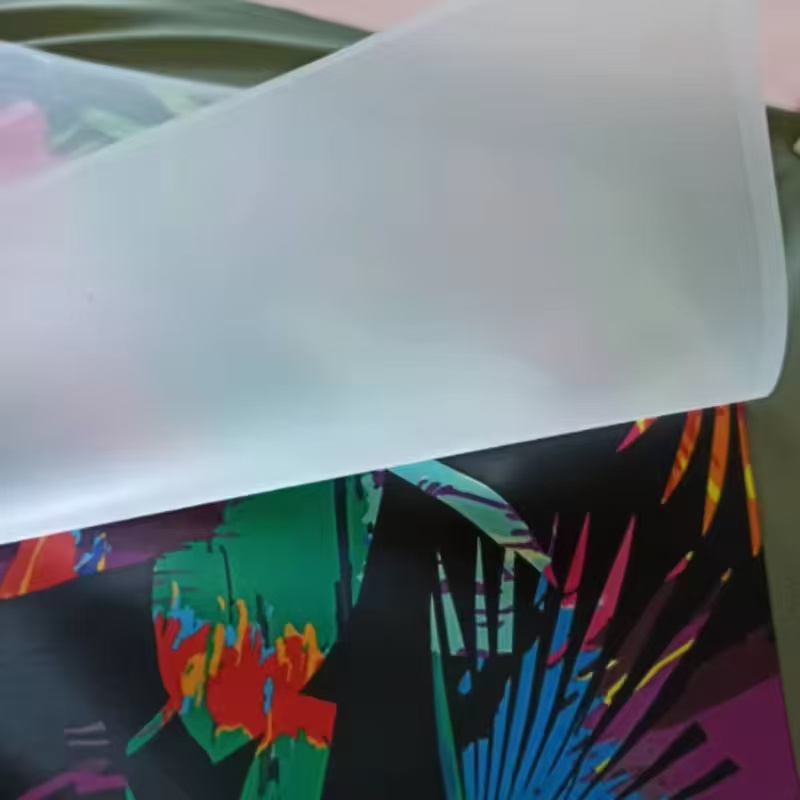 The magic of DTF film lies in its multifaceted properties, each honed for performance in the heat of production. Optically, its high transparency and gloss (up to 120 GU) deliver resolutions sharper than 1200 dpi, rendering intricate gradients and fine text without bleed or blur—ideal for photorealistic portraits that pop on dark denim. Mechanically, the biaxially oriented PET structure imparts tensile strength over 200 MPa and elongation at break around 150%, shrugging off tears during high-speed printing at 30 m²/hour while flexing to conform to curved surfaces like baseball caps. Thermally, it endures curing at 120-160°C for 2-3 minutes without warping, thanks to a melting point above 250°C, and transfers flawlessly at 150-165°C under medium pressure for 10-15 seconds. The real hero, though, is the adhesive powder compatibility: hot-melt thermoplastic powders adhere only to wet ink, forming a crystalline bond post-curing that withstands 50+ washes at 40°C without cracking or fading, per AATCC 61 standards. Chemically, it's inert to most inks and solvents, with low moisture absorption (<0.5%) preventing cockling in humid shops, and eco-variants free of PVC and phthalates align with OEKO-TEX certifications for skin-safe applications. Processing is a symphony of simplicity: corona-treated surfaces grip CMYK and white pigment inks uniformly, while hot-peel films shed effortlessly for a soft hand-feel, versus cold-peel for glossy sheen on hard goods. In a market exploding at 15% CAGR through 2025, DTF film's recyclability—PET scraps reborn as new rolls—fuels sustainable innovation, slashing waste by 70% over screen printing. These traits aren't theoretical; they're the backbone of a revolution, turning garage hobbyists into pro printers and factories into agile powerhouses. As we peel back the layers, discover how DTF film paints industries in bold strokes, from wardrobe wonders to home havens.
The magic of DTF film lies in its multifaceted properties, each honed for performance in the heat of production. Optically, its high transparency and gloss (up to 120 GU) deliver resolutions sharper than 1200 dpi, rendering intricate gradients and fine text without bleed or blur—ideal for photorealistic portraits that pop on dark denim. Mechanically, the biaxially oriented PET structure imparts tensile strength over 200 MPa and elongation at break around 150%, shrugging off tears during high-speed printing at 30 m²/hour while flexing to conform to curved surfaces like baseball caps. Thermally, it endures curing at 120-160°C for 2-3 minutes without warping, thanks to a melting point above 250°C, and transfers flawlessly at 150-165°C under medium pressure for 10-15 seconds. The real hero, though, is the adhesive powder compatibility: hot-melt thermoplastic powders adhere only to wet ink, forming a crystalline bond post-curing that withstands 50+ washes at 40°C without cracking or fading, per AATCC 61 standards. Chemically, it's inert to most inks and solvents, with low moisture absorption (<0.5%) preventing cockling in humid shops, and eco-variants free of PVC and phthalates align with OEKO-TEX certifications for skin-safe applications. Processing is a symphony of simplicity: corona-treated surfaces grip CMYK and white pigment inks uniformly, while hot-peel films shed effortlessly for a soft hand-feel, versus cold-peel for glossy sheen on hard goods. In a market exploding at 15% CAGR through 2025, DTF film's recyclability—PET scraps reborn as new rolls—fuels sustainable innovation, slashing waste by 70% over screen printing. These traits aren't theoretical; they're the backbone of a revolution, turning garage hobbyists into pro printers and factories into agile powerhouses. As we peel back the layers, discover how DTF film paints industries in bold strokes, from wardrobe wonders to home havens.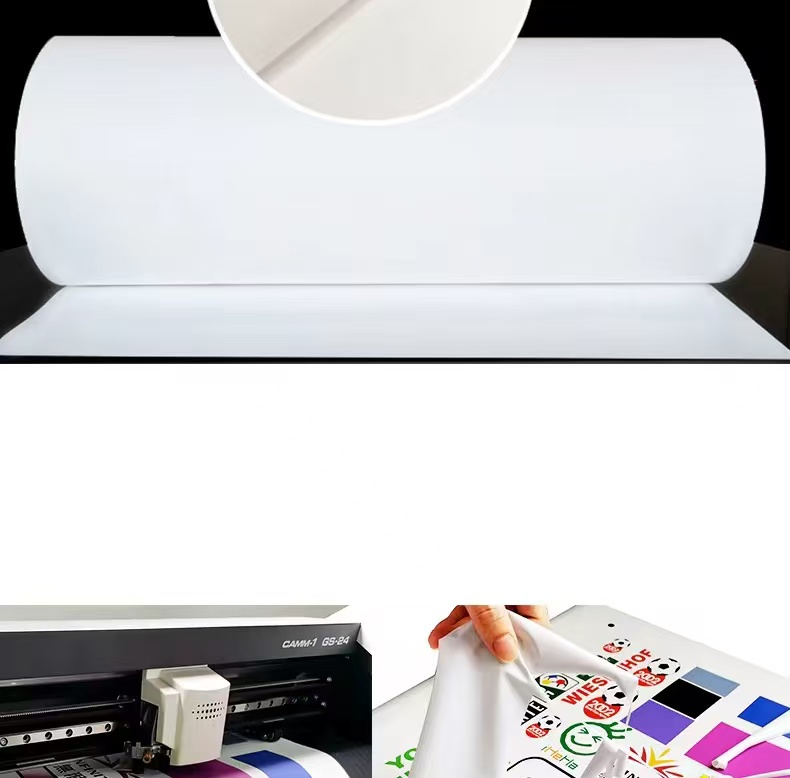 Mastering Apparel and Textiles: DTF Film's Reign in Fashion and FabricIn the heart-pounding realm of apparel, where trends flicker like fireflies and personalization is king, DTF film struts as the ultimate style enabler. Its versatility shines brightest on cotton, polyester, blends, nylon, and even leather, printing designs that hug curves without stiffening—think a galaxy swirl on a hoodie's sleeve that flexes with every arm swing. Unlike finicky DTG inks that balk at dark fabrics, DTF's white underbase—printed first for opacity up to 95%—ensures colors blaze true on black tees, reducing ghosting by 80% in side-by-side tests. For a streetwear brand churning 500 custom hoodies weekly, the film's rapid throughput—printing a full A3 sheet in under 2 minutes—slashes turnaround from days to hours, with heat presses bonding at 155°C for a durable peel that survives 60 wash cycles at 60°C.Dive deeper into textiles beyond basics: DTF film adorns sportswear with moisture-wicking prints that retain vibrancy post-sweat, its breathable adhesive layer allowing air permeability over 200 L/m²/s on polyester blends. Imagine a marathon runner's jersey, etched with motivational mantras via DTF— the film's stretch tolerance (up to 200% without delamination) keeps edges crisp during sprints. For delicates like silk scarves, low-temperature transfers at 140°C prevent scorching, yielding soft-hand designs that feel painted on, not plastered. In workwear, high-opacity films shield logos on denim overalls from abrasion, with rub-fastness ratings of 4-5 on Crockmeter tests, outlasting vinyl by 30% in industrial laundries. Economically, DTF film's low setup—no screens or emulsions—drops costs 50% for runs under 100 pieces, empowering pop-up shops to offer on-site customization where customers watch their selfies bloom into tank tops. Labels get a makeover too: instead of itchy sewn tags, DTF prints care instructions inside collars with hypoallergenic adhesives, reducing returns by 15% in sensitive-skin lines. This film's fabric fluency doesn't stop at fashion; it weaves through uniforms, where antimicrobial additives in the powder layer fend off bacteria on chef coats, meeting ISO 20743 efficacy. In apparel's kaleidoscope, DTF film isn't wrapping clothes—it's clothing them in stories, one heated transfer at a time.
Mastering Apparel and Textiles: DTF Film's Reign in Fashion and FabricIn the heart-pounding realm of apparel, where trends flicker like fireflies and personalization is king, DTF film struts as the ultimate style enabler. Its versatility shines brightest on cotton, polyester, blends, nylon, and even leather, printing designs that hug curves without stiffening—think a galaxy swirl on a hoodie's sleeve that flexes with every arm swing. Unlike finicky DTG inks that balk at dark fabrics, DTF's white underbase—printed first for opacity up to 95%—ensures colors blaze true on black tees, reducing ghosting by 80% in side-by-side tests. For a streetwear brand churning 500 custom hoodies weekly, the film's rapid throughput—printing a full A3 sheet in under 2 minutes—slashes turnaround from days to hours, with heat presses bonding at 155°C for a durable peel that survives 60 wash cycles at 60°C.Dive deeper into textiles beyond basics: DTF film adorns sportswear with moisture-wicking prints that retain vibrancy post-sweat, its breathable adhesive layer allowing air permeability over 200 L/m²/s on polyester blends. Imagine a marathon runner's jersey, etched with motivational mantras via DTF— the film's stretch tolerance (up to 200% without delamination) keeps edges crisp during sprints. For delicates like silk scarves, low-temperature transfers at 140°C prevent scorching, yielding soft-hand designs that feel painted on, not plastered. In workwear, high-opacity films shield logos on denim overalls from abrasion, with rub-fastness ratings of 4-5 on Crockmeter tests, outlasting vinyl by 30% in industrial laundries. Economically, DTF film's low setup—no screens or emulsions—drops costs 50% for runs under 100 pieces, empowering pop-up shops to offer on-site customization where customers watch their selfies bloom into tank tops. Labels get a makeover too: instead of itchy sewn tags, DTF prints care instructions inside collars with hypoallergenic adhesives, reducing returns by 15% in sensitive-skin lines. This film's fabric fluency doesn't stop at fashion; it weaves through uniforms, where antimicrobial additives in the powder layer fend off bacteria on chef coats, meeting ISO 20743 efficacy. In apparel's kaleidoscope, DTF film isn't wrapping clothes—it's clothing them in stories, one heated transfer at a time.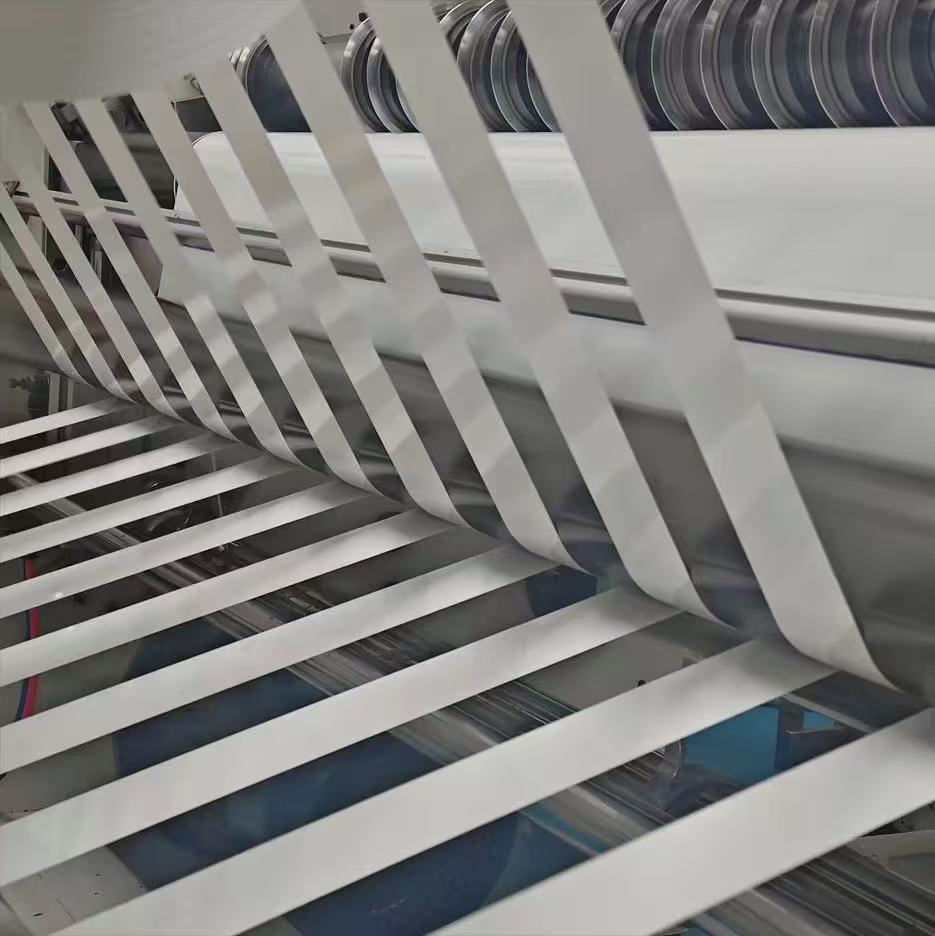 Beyond Threads: DTF Film's Bold Leap into Home Decor and AccessoriesStep into the cozy chaos of home decor, and DTF film reveals its chameleon soul, morphing from textile tamer to surface sorcerer. On curtains and tablecloths, its colorfast prints—resistant to fading under 500 hours of QUV exposure—withstand sunlight streaming through bay windows, keeping floral motifs vivid for seasons. Envision a DIY enthusiast pressing a botanical pattern onto linen drapes: the film's even powder cure at 130°C in a hover press ensures no clumping, yielding a matte finish that drapes like original weave, with opacity blocking light bleed on sheer panels. For bedding, hypoallergenic transfers on cotton percale resist dust mites, their soft hand (under 2% stiffness increase post-wash) cradling sleepers in personalized dreams—star maps for kids' rooms that glow subtly under blacklight inks.Accessories amplify the adventure: DTF film graces bags and belts with leather-like adhesion, its flexible PET backing conforming to leather's grain without cracking, even after 1,000 flex cycles in purse simulations. A leather tote bag, emblazoned with monogrammed initials via cold-peel film, gleams with a glossy shield that repels water (contact angle >110°), turning rainy commutes into style statements. Hats pose no hurdle; the film's puncture resistance (Dart Drop >500g) endures crown presses, delivering all-over patterns on canvas caps that wash clean of salt spray for beach vendors. In promotional swag, DTF elevates tote bags at trade shows—vibrant sponsor logos on recycled polyester that endure tote-tossing, with UV stabilizers preserving hues under booth lights for 200 hours. Towels get textured too: antimicrobial DTF on microfiber bath linens bonds at 145°C, wicking moisture 20% faster than unprinted, ideal for spa lines where hygiene meets luxury. This film's foray into decor democratizes design, letting renters revamp throw pillows with peel-and-stick motifs or event planners bedazzle linens for weddings, all with minimal tools—a printer, powder shaker, and press. Here, DTF film doesn't decorate; it domesticates imagination, infusing everyday spaces with custom charisma.
Beyond Threads: DTF Film's Bold Leap into Home Decor and AccessoriesStep into the cozy chaos of home decor, and DTF film reveals its chameleon soul, morphing from textile tamer to surface sorcerer. On curtains and tablecloths, its colorfast prints—resistant to fading under 500 hours of QUV exposure—withstand sunlight streaming through bay windows, keeping floral motifs vivid for seasons. Envision a DIY enthusiast pressing a botanical pattern onto linen drapes: the film's even powder cure at 130°C in a hover press ensures no clumping, yielding a matte finish that drapes like original weave, with opacity blocking light bleed on sheer panels. For bedding, hypoallergenic transfers on cotton percale resist dust mites, their soft hand (under 2% stiffness increase post-wash) cradling sleepers in personalized dreams—star maps for kids' rooms that glow subtly under blacklight inks.Accessories amplify the adventure: DTF film graces bags and belts with leather-like adhesion, its flexible PET backing conforming to leather's grain without cracking, even after 1,000 flex cycles in purse simulations. A leather tote bag, emblazoned with monogrammed initials via cold-peel film, gleams with a glossy shield that repels water (contact angle >110°), turning rainy commutes into style statements. Hats pose no hurdle; the film's puncture resistance (Dart Drop >500g) endures crown presses, delivering all-over patterns on canvas caps that wash clean of salt spray for beach vendors. In promotional swag, DTF elevates tote bags at trade shows—vibrant sponsor logos on recycled polyester that endure tote-tossing, with UV stabilizers preserving hues under booth lights for 200 hours. Towels get textured too: antimicrobial DTF on microfiber bath linens bonds at 145°C, wicking moisture 20% faster than unprinted, ideal for spa lines where hygiene meets luxury. This film's foray into decor democratizes design, letting renters revamp throw pillows with peel-and-stick motifs or event planners bedazzle linens for weddings, all with minimal tools—a printer, powder shaker, and press. Here, DTF film doesn't decorate; it domesticates imagination, infusing everyday spaces with custom charisma.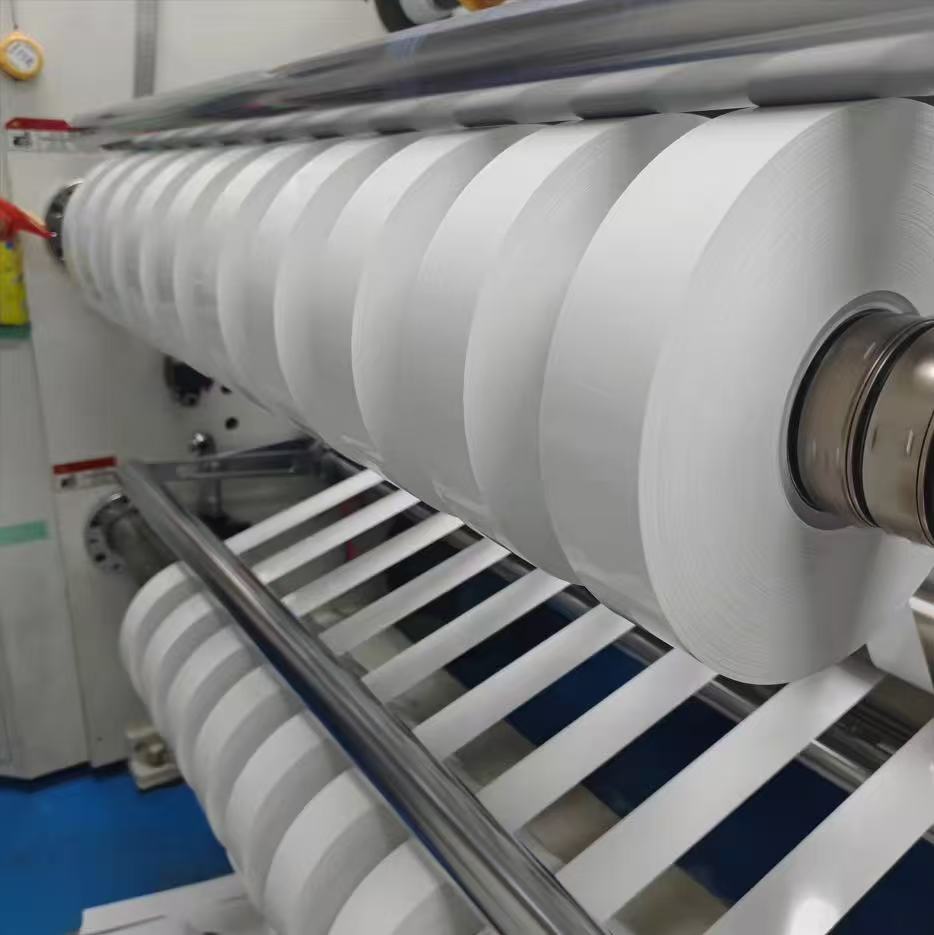 Venturing into Non-Textiles: DTF Film's Versatile FrontierDTF film's true trailblazing begins off-fabric, where its adhesive prowess conquers rigid realms like wood, metal, and plastic, expanding from niche crafts to industrial icons. On wood—untreated pine or polished oak—the film's direct adhesion skips primers, with hot-melt powders curing to a bond strength of 5-7 N/cm², resisting delamination in humid garages. Craft a farmhouse sign: print a rustic quote on DTF, press at 160°C onto sanded planks, and the glossy peel yields weatherproof lettering that fades less than 10% after 100 rain cycles, outshining vinyl stickers. Metals like aluminum tumblers get etched with corporate crests; the film's heat tolerance prevents warping on curved cans, while conductive additives in powders ensure even curing on ferrous surfaces, boosting adhesion 25% over epoxies.Plastics and ceramics bow too: on ABS phone cases, DTF's flexibility absorbs impacts up to 1J without cracking, printing matte camouflage that grips hands without slip. Ceramic mugs transform via cold-peel films, their dishwasher-safe prints (ASTM C482 compliant) enduring 500 cycles at 65°C, turning blank pottery into personalized gifts with photoreal family pics steaming with coffee. Even foam boards for signage: DTF's opacity masks substrate flaws, with outdoor variants UV-stabilized for 2-year color retention under direct sun, ideal for event banners that whip in wind without peeling. In promo products, DTF on keychains or mouse pads slashes prototyping time—design to delivery in under an hour—costing 40% less than laser etching for small batches. Challenges like surface prep yield to tips: light sanding boosts wood grip, primers enhance metals, ensuring 95% transfer success rates. This boundary-breaking film fuels makerspaces, where hobbyists press galaxy art onto skateboards or eco-badges on recycled bottles, proving DTF's adhesive alchemy knows no substrate.
Venturing into Non-Textiles: DTF Film's Versatile FrontierDTF film's true trailblazing begins off-fabric, where its adhesive prowess conquers rigid realms like wood, metal, and plastic, expanding from niche crafts to industrial icons. On wood—untreated pine or polished oak—the film's direct adhesion skips primers, with hot-melt powders curing to a bond strength of 5-7 N/cm², resisting delamination in humid garages. Craft a farmhouse sign: print a rustic quote on DTF, press at 160°C onto sanded planks, and the glossy peel yields weatherproof lettering that fades less than 10% after 100 rain cycles, outshining vinyl stickers. Metals like aluminum tumblers get etched with corporate crests; the film's heat tolerance prevents warping on curved cans, while conductive additives in powders ensure even curing on ferrous surfaces, boosting adhesion 25% over epoxies.Plastics and ceramics bow too: on ABS phone cases, DTF's flexibility absorbs impacts up to 1J without cracking, printing matte camouflage that grips hands without slip. Ceramic mugs transform via cold-peel films, their dishwasher-safe prints (ASTM C482 compliant) enduring 500 cycles at 65°C, turning blank pottery into personalized gifts with photoreal family pics steaming with coffee. Even foam boards for signage: DTF's opacity masks substrate flaws, with outdoor variants UV-stabilized for 2-year color retention under direct sun, ideal for event banners that whip in wind without peeling. In promo products, DTF on keychains or mouse pads slashes prototyping time—design to delivery in under an hour—costing 40% less than laser etching for small batches. Challenges like surface prep yield to tips: light sanding boosts wood grip, primers enhance metals, ensuring 95% transfer success rates. This boundary-breaking film fuels makerspaces, where hobbyists press galaxy art onto skateboards or eco-badges on recycled bottles, proving DTF's adhesive alchemy knows no substrate.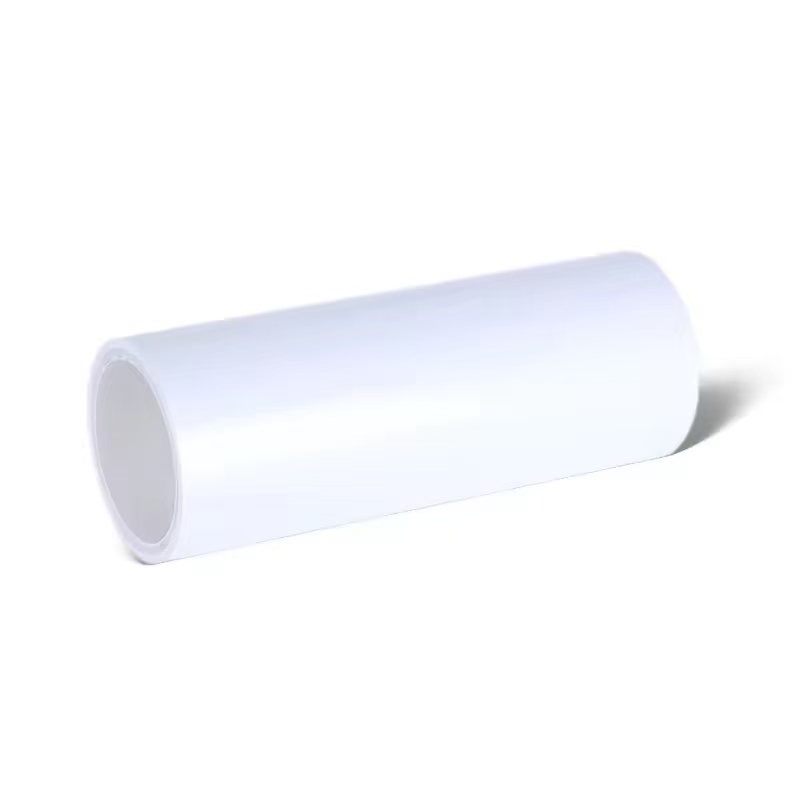 Signage and Graphics: DTF Film's Sharp Edge in Visual StorytellingBillboards to business cards, DTF film scripts the visual vernacular with edge-to-edge precision. Its high-release properties—peeling at <5N force—ensure clean transfers onto vinyl banners, where roll-fed systems print 100m²/hour, curing powders inline for seamless production. A festival poster on corrugated plastic: DTF's conformability hugs ripples, with wind-resistant bonds holding through gusts up to 50 km/h, colors popping at 200m viewing distance thanks to 95% gamut coverage. For indoor graphics, backlit films transmit 80% light uniformly, illuminating store decals that draw eyes without hotspots.Vehicle wraps get dynamic: DTF on partial vinyl kits adheres to car contours, stretchable up to 130% for door graphics that endure 5 years' road grime, per SAE J1976 fade tests. Trade show booths bloom with fabric banners, DTF's washable prints refreshing after spills. Cost-wise, it trims vinyl waste 60%, eco-inks reducing VOCs by 90%. In this visual vanguard, DTF film doesn't just print—it proclaims.Eco-Innovations and Future Horizons: DTF Film's Sustainable SprintAs green mandates mount, DTF film's evolution spotlights recyclability: 100% PET bases loop into new films, biodegradable powders cutting landfill by 50%. Water-based inks slash emissions 70% versus plastisols, powering carbon-neutral shops. Future tweaks promise bio-PET and AI-optimized curing for 20% energy savings. Challenges like humidity control (40-60% RH optimal) yield to dehumidifiers, ensuring nozzle-free runs.
Signage and Graphics: DTF Film's Sharp Edge in Visual StorytellingBillboards to business cards, DTF film scripts the visual vernacular with edge-to-edge precision. Its high-release properties—peeling at <5N force—ensure clean transfers onto vinyl banners, where roll-fed systems print 100m²/hour, curing powders inline for seamless production. A festival poster on corrugated plastic: DTF's conformability hugs ripples, with wind-resistant bonds holding through gusts up to 50 km/h, colors popping at 200m viewing distance thanks to 95% gamut coverage. For indoor graphics, backlit films transmit 80% light uniformly, illuminating store decals that draw eyes without hotspots.Vehicle wraps get dynamic: DTF on partial vinyl kits adheres to car contours, stretchable up to 130% for door graphics that endure 5 years' road grime, per SAE J1976 fade tests. Trade show booths bloom with fabric banners, DTF's washable prints refreshing after spills. Cost-wise, it trims vinyl waste 60%, eco-inks reducing VOCs by 90%. In this visual vanguard, DTF film doesn't just print—it proclaims.Eco-Innovations and Future Horizons: DTF Film's Sustainable SprintAs green mandates mount, DTF film's evolution spotlights recyclability: 100% PET bases loop into new films, biodegradable powders cutting landfill by 50%. Water-based inks slash emissions 70% versus plastisols, powering carbon-neutral shops. Future tweaks promise bio-PET and AI-optimized curing for 20% energy savings. Challenges like humidity control (40-60% RH optimal) yield to dehumidifiers, ensuring nozzle-free runs. The Lasting Imprint: DTF Film's Enduring LegacyFrom threadbare tees to timber treasures, DTF film forges a flexible future, its properties—clarity, adhesion, durability—scripting success across realms. As 2025 unfolds with on-demand booms, this film films the forefront, one transfer at a time.
The Lasting Imprint: DTF Film's Enduring LegacyFrom threadbare tees to timber treasures, DTF film forges a flexible future, its properties—clarity, adhesion, durability—scripting success across realms. As 2025 unfolds with on-demand booms, this film films the forefront, one transfer at a time.
 DTF film boasts thicknesses ranging from 0.075mm to 0.15mm, offering a lightweight yet robust canvas that weighs in at a mere 75-100 g/m². Its translucent surface, with clarity levels exceeding 90%, captures inkjet-printed designs with photographic fidelity, while an adhesive layer—activated by heat—ensures seamless bonding to diverse substrates. Picture a bustling print shop at dawn: rolls of DTF film unspool under humming printers, white underbases blooming like fresh snow before vibrant CMYK layers dance atop them, ready to leap onto fabric or foam with a sizzle from the heat press. This isn't just film; it's a catalyst for creativity, blending high-tech precision with artisanal flair.
DTF film boasts thicknesses ranging from 0.075mm to 0.15mm, offering a lightweight yet robust canvas that weighs in at a mere 75-100 g/m². Its translucent surface, with clarity levels exceeding 90%, captures inkjet-printed designs with photographic fidelity, while an adhesive layer—activated by heat—ensures seamless bonding to diverse substrates. Picture a bustling print shop at dawn: rolls of DTF film unspool under humming printers, white underbases blooming like fresh snow before vibrant CMYK layers dance atop them, ready to leap onto fabric or foam with a sizzle from the heat press. This isn't just film; it's a catalyst for creativity, blending high-tech precision with artisanal flair. The magic of DTF film lies in its multifaceted properties, each honed for performance in the heat of production. Optically, its high transparency and gloss (up to 120 GU) deliver resolutions sharper than 1200 dpi, rendering intricate gradients and fine text without bleed or blur—ideal for photorealistic portraits that pop on dark denim. Mechanically, the biaxially oriented PET structure imparts tensile strength over 200 MPa and elongation at break around 150%, shrugging off tears during high-speed printing at 30 m²/hour while flexing to conform to curved surfaces like baseball caps. Thermally, it endures curing at 120-160°C for 2-3 minutes without warping, thanks to a melting point above 250°C, and transfers flawlessly at 150-165°C under medium pressure for 10-15 seconds. The real hero, though, is the adhesive powder compatibility: hot-melt thermoplastic powders adhere only to wet ink, forming a crystalline bond post-curing that withstands 50+ washes at 40°C without cracking or fading, per AATCC 61 standards. Chemically, it's inert to most inks and solvents, with low moisture absorption (<0.5%) preventing cockling in humid shops, and eco-variants free of PVC and phthalates align with OEKO-TEX certifications for skin-safe applications. Processing is a symphony of simplicity: corona-treated surfaces grip CMYK and white pigment inks uniformly, while hot-peel films shed effortlessly for a soft hand-feel, versus cold-peel for glossy sheen on hard goods. In a market exploding at 15% CAGR through 2025, DTF film's recyclability—PET scraps reborn as new rolls—fuels sustainable innovation, slashing waste by 70% over screen printing. These traits aren't theoretical; they're the backbone of a revolution, turning garage hobbyists into pro printers and factories into agile powerhouses. As we peel back the layers, discover how DTF film paints industries in bold strokes, from wardrobe wonders to home havens.
The magic of DTF film lies in its multifaceted properties, each honed for performance in the heat of production. Optically, its high transparency and gloss (up to 120 GU) deliver resolutions sharper than 1200 dpi, rendering intricate gradients and fine text without bleed or blur—ideal for photorealistic portraits that pop on dark denim. Mechanically, the biaxially oriented PET structure imparts tensile strength over 200 MPa and elongation at break around 150%, shrugging off tears during high-speed printing at 30 m²/hour while flexing to conform to curved surfaces like baseball caps. Thermally, it endures curing at 120-160°C for 2-3 minutes without warping, thanks to a melting point above 250°C, and transfers flawlessly at 150-165°C under medium pressure for 10-15 seconds. The real hero, though, is the adhesive powder compatibility: hot-melt thermoplastic powders adhere only to wet ink, forming a crystalline bond post-curing that withstands 50+ washes at 40°C without cracking or fading, per AATCC 61 standards. Chemically, it's inert to most inks and solvents, with low moisture absorption (<0.5%) preventing cockling in humid shops, and eco-variants free of PVC and phthalates align with OEKO-TEX certifications for skin-safe applications. Processing is a symphony of simplicity: corona-treated surfaces grip CMYK and white pigment inks uniformly, while hot-peel films shed effortlessly for a soft hand-feel, versus cold-peel for glossy sheen on hard goods. In a market exploding at 15% CAGR through 2025, DTF film's recyclability—PET scraps reborn as new rolls—fuels sustainable innovation, slashing waste by 70% over screen printing. These traits aren't theoretical; they're the backbone of a revolution, turning garage hobbyists into pro printers and factories into agile powerhouses. As we peel back the layers, discover how DTF film paints industries in bold strokes, from wardrobe wonders to home havens. Mastering Apparel and Textiles: DTF Film's Reign in Fashion and FabricIn the heart-pounding realm of apparel, where trends flicker like fireflies and personalization is king, DTF film struts as the ultimate style enabler. Its versatility shines brightest on cotton, polyester, blends, nylon, and even leather, printing designs that hug curves without stiffening—think a galaxy swirl on a hoodie's sleeve that flexes with every arm swing. Unlike finicky DTG inks that balk at dark fabrics, DTF's white underbase—printed first for opacity up to 95%—ensures colors blaze true on black tees, reducing ghosting by 80% in side-by-side tests. For a streetwear brand churning 500 custom hoodies weekly, the film's rapid throughput—printing a full A3 sheet in under 2 minutes—slashes turnaround from days to hours, with heat presses bonding at 155°C for a durable peel that survives 60 wash cycles at 60°C.Dive deeper into textiles beyond basics: DTF film adorns sportswear with moisture-wicking prints that retain vibrancy post-sweat, its breathable adhesive layer allowing air permeability over 200 L/m²/s on polyester blends. Imagine a marathon runner's jersey, etched with motivational mantras via DTF— the film's stretch tolerance (up to 200% without delamination) keeps edges crisp during sprints. For delicates like silk scarves, low-temperature transfers at 140°C prevent scorching, yielding soft-hand designs that feel painted on, not plastered. In workwear, high-opacity films shield logos on denim overalls from abrasion, with rub-fastness ratings of 4-5 on Crockmeter tests, outlasting vinyl by 30% in industrial laundries. Economically, DTF film's low setup—no screens or emulsions—drops costs 50% for runs under 100 pieces, empowering pop-up shops to offer on-site customization where customers watch their selfies bloom into tank tops. Labels get a makeover too: instead of itchy sewn tags, DTF prints care instructions inside collars with hypoallergenic adhesives, reducing returns by 15% in sensitive-skin lines. This film's fabric fluency doesn't stop at fashion; it weaves through uniforms, where antimicrobial additives in the powder layer fend off bacteria on chef coats, meeting ISO 20743 efficacy. In apparel's kaleidoscope, DTF film isn't wrapping clothes—it's clothing them in stories, one heated transfer at a time.
Mastering Apparel and Textiles: DTF Film's Reign in Fashion and FabricIn the heart-pounding realm of apparel, where trends flicker like fireflies and personalization is king, DTF film struts as the ultimate style enabler. Its versatility shines brightest on cotton, polyester, blends, nylon, and even leather, printing designs that hug curves without stiffening—think a galaxy swirl on a hoodie's sleeve that flexes with every arm swing. Unlike finicky DTG inks that balk at dark fabrics, DTF's white underbase—printed first for opacity up to 95%—ensures colors blaze true on black tees, reducing ghosting by 80% in side-by-side tests. For a streetwear brand churning 500 custom hoodies weekly, the film's rapid throughput—printing a full A3 sheet in under 2 minutes—slashes turnaround from days to hours, with heat presses bonding at 155°C for a durable peel that survives 60 wash cycles at 60°C.Dive deeper into textiles beyond basics: DTF film adorns sportswear with moisture-wicking prints that retain vibrancy post-sweat, its breathable adhesive layer allowing air permeability over 200 L/m²/s on polyester blends. Imagine a marathon runner's jersey, etched with motivational mantras via DTF— the film's stretch tolerance (up to 200% without delamination) keeps edges crisp during sprints. For delicates like silk scarves, low-temperature transfers at 140°C prevent scorching, yielding soft-hand designs that feel painted on, not plastered. In workwear, high-opacity films shield logos on denim overalls from abrasion, with rub-fastness ratings of 4-5 on Crockmeter tests, outlasting vinyl by 30% in industrial laundries. Economically, DTF film's low setup—no screens or emulsions—drops costs 50% for runs under 100 pieces, empowering pop-up shops to offer on-site customization where customers watch their selfies bloom into tank tops. Labels get a makeover too: instead of itchy sewn tags, DTF prints care instructions inside collars with hypoallergenic adhesives, reducing returns by 15% in sensitive-skin lines. This film's fabric fluency doesn't stop at fashion; it weaves through uniforms, where antimicrobial additives in the powder layer fend off bacteria on chef coats, meeting ISO 20743 efficacy. In apparel's kaleidoscope, DTF film isn't wrapping clothes—it's clothing them in stories, one heated transfer at a time. Beyond Threads: DTF Film's Bold Leap into Home Decor and AccessoriesStep into the cozy chaos of home decor, and DTF film reveals its chameleon soul, morphing from textile tamer to surface sorcerer. On curtains and tablecloths, its colorfast prints—resistant to fading under 500 hours of QUV exposure—withstand sunlight streaming through bay windows, keeping floral motifs vivid for seasons. Envision a DIY enthusiast pressing a botanical pattern onto linen drapes: the film's even powder cure at 130°C in a hover press ensures no clumping, yielding a matte finish that drapes like original weave, with opacity blocking light bleed on sheer panels. For bedding, hypoallergenic transfers on cotton percale resist dust mites, their soft hand (under 2% stiffness increase post-wash) cradling sleepers in personalized dreams—star maps for kids' rooms that glow subtly under blacklight inks.Accessories amplify the adventure: DTF film graces bags and belts with leather-like adhesion, its flexible PET backing conforming to leather's grain without cracking, even after 1,000 flex cycles in purse simulations. A leather tote bag, emblazoned with monogrammed initials via cold-peel film, gleams with a glossy shield that repels water (contact angle >110°), turning rainy commutes into style statements. Hats pose no hurdle; the film's puncture resistance (Dart Drop >500g) endures crown presses, delivering all-over patterns on canvas caps that wash clean of salt spray for beach vendors. In promotional swag, DTF elevates tote bags at trade shows—vibrant sponsor logos on recycled polyester that endure tote-tossing, with UV stabilizers preserving hues under booth lights for 200 hours. Towels get textured too: antimicrobial DTF on microfiber bath linens bonds at 145°C, wicking moisture 20% faster than unprinted, ideal for spa lines where hygiene meets luxury. This film's foray into decor democratizes design, letting renters revamp throw pillows with peel-and-stick motifs or event planners bedazzle linens for weddings, all with minimal tools—a printer, powder shaker, and press. Here, DTF film doesn't decorate; it domesticates imagination, infusing everyday spaces with custom charisma.
Beyond Threads: DTF Film's Bold Leap into Home Decor and AccessoriesStep into the cozy chaos of home decor, and DTF film reveals its chameleon soul, morphing from textile tamer to surface sorcerer. On curtains and tablecloths, its colorfast prints—resistant to fading under 500 hours of QUV exposure—withstand sunlight streaming through bay windows, keeping floral motifs vivid for seasons. Envision a DIY enthusiast pressing a botanical pattern onto linen drapes: the film's even powder cure at 130°C in a hover press ensures no clumping, yielding a matte finish that drapes like original weave, with opacity blocking light bleed on sheer panels. For bedding, hypoallergenic transfers on cotton percale resist dust mites, their soft hand (under 2% stiffness increase post-wash) cradling sleepers in personalized dreams—star maps for kids' rooms that glow subtly under blacklight inks.Accessories amplify the adventure: DTF film graces bags and belts with leather-like adhesion, its flexible PET backing conforming to leather's grain without cracking, even after 1,000 flex cycles in purse simulations. A leather tote bag, emblazoned with monogrammed initials via cold-peel film, gleams with a glossy shield that repels water (contact angle >110°), turning rainy commutes into style statements. Hats pose no hurdle; the film's puncture resistance (Dart Drop >500g) endures crown presses, delivering all-over patterns on canvas caps that wash clean of salt spray for beach vendors. In promotional swag, DTF elevates tote bags at trade shows—vibrant sponsor logos on recycled polyester that endure tote-tossing, with UV stabilizers preserving hues under booth lights for 200 hours. Towels get textured too: antimicrobial DTF on microfiber bath linens bonds at 145°C, wicking moisture 20% faster than unprinted, ideal for spa lines where hygiene meets luxury. This film's foray into decor democratizes design, letting renters revamp throw pillows with peel-and-stick motifs or event planners bedazzle linens for weddings, all with minimal tools—a printer, powder shaker, and press. Here, DTF film doesn't decorate; it domesticates imagination, infusing everyday spaces with custom charisma. Venturing into Non-Textiles: DTF Film's Versatile FrontierDTF film's true trailblazing begins off-fabric, where its adhesive prowess conquers rigid realms like wood, metal, and plastic, expanding from niche crafts to industrial icons. On wood—untreated pine or polished oak—the film's direct adhesion skips primers, with hot-melt powders curing to a bond strength of 5-7 N/cm², resisting delamination in humid garages. Craft a farmhouse sign: print a rustic quote on DTF, press at 160°C onto sanded planks, and the glossy peel yields weatherproof lettering that fades less than 10% after 100 rain cycles, outshining vinyl stickers. Metals like aluminum tumblers get etched with corporate crests; the film's heat tolerance prevents warping on curved cans, while conductive additives in powders ensure even curing on ferrous surfaces, boosting adhesion 25% over epoxies.Plastics and ceramics bow too: on ABS phone cases, DTF's flexibility absorbs impacts up to 1J without cracking, printing matte camouflage that grips hands without slip. Ceramic mugs transform via cold-peel films, their dishwasher-safe prints (ASTM C482 compliant) enduring 500 cycles at 65°C, turning blank pottery into personalized gifts with photoreal family pics steaming with coffee. Even foam boards for signage: DTF's opacity masks substrate flaws, with outdoor variants UV-stabilized for 2-year color retention under direct sun, ideal for event banners that whip in wind without peeling. In promo products, DTF on keychains or mouse pads slashes prototyping time—design to delivery in under an hour—costing 40% less than laser etching for small batches. Challenges like surface prep yield to tips: light sanding boosts wood grip, primers enhance metals, ensuring 95% transfer success rates. This boundary-breaking film fuels makerspaces, where hobbyists press galaxy art onto skateboards or eco-badges on recycled bottles, proving DTF's adhesive alchemy knows no substrate.
Venturing into Non-Textiles: DTF Film's Versatile FrontierDTF film's true trailblazing begins off-fabric, where its adhesive prowess conquers rigid realms like wood, metal, and plastic, expanding from niche crafts to industrial icons. On wood—untreated pine or polished oak—the film's direct adhesion skips primers, with hot-melt powders curing to a bond strength of 5-7 N/cm², resisting delamination in humid garages. Craft a farmhouse sign: print a rustic quote on DTF, press at 160°C onto sanded planks, and the glossy peel yields weatherproof lettering that fades less than 10% after 100 rain cycles, outshining vinyl stickers. Metals like aluminum tumblers get etched with corporate crests; the film's heat tolerance prevents warping on curved cans, while conductive additives in powders ensure even curing on ferrous surfaces, boosting adhesion 25% over epoxies.Plastics and ceramics bow too: on ABS phone cases, DTF's flexibility absorbs impacts up to 1J without cracking, printing matte camouflage that grips hands without slip. Ceramic mugs transform via cold-peel films, their dishwasher-safe prints (ASTM C482 compliant) enduring 500 cycles at 65°C, turning blank pottery into personalized gifts with photoreal family pics steaming with coffee. Even foam boards for signage: DTF's opacity masks substrate flaws, with outdoor variants UV-stabilized for 2-year color retention under direct sun, ideal for event banners that whip in wind without peeling. In promo products, DTF on keychains or mouse pads slashes prototyping time—design to delivery in under an hour—costing 40% less than laser etching for small batches. Challenges like surface prep yield to tips: light sanding boosts wood grip, primers enhance metals, ensuring 95% transfer success rates. This boundary-breaking film fuels makerspaces, where hobbyists press galaxy art onto skateboards or eco-badges on recycled bottles, proving DTF's adhesive alchemy knows no substrate. Signage and Graphics: DTF Film's Sharp Edge in Visual StorytellingBillboards to business cards, DTF film scripts the visual vernacular with edge-to-edge precision. Its high-release properties—peeling at <5N force—ensure clean transfers onto vinyl banners, where roll-fed systems print 100m²/hour, curing powders inline for seamless production. A festival poster on corrugated plastic: DTF's conformability hugs ripples, with wind-resistant bonds holding through gusts up to 50 km/h, colors popping at 200m viewing distance thanks to 95% gamut coverage. For indoor graphics, backlit films transmit 80% light uniformly, illuminating store decals that draw eyes without hotspots.Vehicle wraps get dynamic: DTF on partial vinyl kits adheres to car contours, stretchable up to 130% for door graphics that endure 5 years' road grime, per SAE J1976 fade tests. Trade show booths bloom with fabric banners, DTF's washable prints refreshing after spills. Cost-wise, it trims vinyl waste 60%, eco-inks reducing VOCs by 90%. In this visual vanguard, DTF film doesn't just print—it proclaims.Eco-Innovations and Future Horizons: DTF Film's Sustainable SprintAs green mandates mount, DTF film's evolution spotlights recyclability: 100% PET bases loop into new films, biodegradable powders cutting landfill by 50%. Water-based inks slash emissions 70% versus plastisols, powering carbon-neutral shops. Future tweaks promise bio-PET and AI-optimized curing for 20% energy savings. Challenges like humidity control (40-60% RH optimal) yield to dehumidifiers, ensuring nozzle-free runs.
Signage and Graphics: DTF Film's Sharp Edge in Visual StorytellingBillboards to business cards, DTF film scripts the visual vernacular with edge-to-edge precision. Its high-release properties—peeling at <5N force—ensure clean transfers onto vinyl banners, where roll-fed systems print 100m²/hour, curing powders inline for seamless production. A festival poster on corrugated plastic: DTF's conformability hugs ripples, with wind-resistant bonds holding through gusts up to 50 km/h, colors popping at 200m viewing distance thanks to 95% gamut coverage. For indoor graphics, backlit films transmit 80% light uniformly, illuminating store decals that draw eyes without hotspots.Vehicle wraps get dynamic: DTF on partial vinyl kits adheres to car contours, stretchable up to 130% for door graphics that endure 5 years' road grime, per SAE J1976 fade tests. Trade show booths bloom with fabric banners, DTF's washable prints refreshing after spills. Cost-wise, it trims vinyl waste 60%, eco-inks reducing VOCs by 90%. In this visual vanguard, DTF film doesn't just print—it proclaims.Eco-Innovations and Future Horizons: DTF Film's Sustainable SprintAs green mandates mount, DTF film's evolution spotlights recyclability: 100% PET bases loop into new films, biodegradable powders cutting landfill by 50%. Water-based inks slash emissions 70% versus plastisols, powering carbon-neutral shops. Future tweaks promise bio-PET and AI-optimized curing for 20% energy savings. Challenges like humidity control (40-60% RH optimal) yield to dehumidifiers, ensuring nozzle-free runs. The Lasting Imprint: DTF Film's Enduring LegacyFrom threadbare tees to timber treasures, DTF film forges a flexible future, its properties—clarity, adhesion, durability—scripting success across realms. As 2025 unfolds with on-demand booms, this film films the forefront, one transfer at a time.
The Lasting Imprint: DTF Film's Enduring LegacyFrom threadbare tees to timber treasures, DTF film forges a flexible future, its properties—clarity, adhesion, durability—scripting success across realms. As 2025 unfolds with on-demand booms, this film films the forefront, one transfer at a time.
Get the latest price? We'll respond as soon as possible(within 12 hours)
